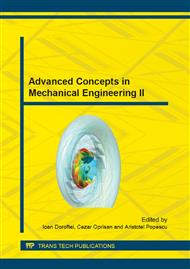[1]
E. M. Tent, P.K. Wright, Metal cutting theory, fourth edition, Butterworth- Heinwmann, Boston, MA, (2000).
Google Scholar
[2]
P. Mullar-Humme, M. Lahr's, A new instrument to optimize cutting process, In situ temperature measurement on diamond coated tools, Innovations in material research 1 (1996) 1-9.
Google Scholar
[3]
C. Tache, I. Petre, D. Dumitru, Studies about determination of the tool temperature during the cutting process, Proceedings of the 4th International conference on advanced manufacturing technologies, Editura Academiei Romane, Bucuresti, 2005, 525 – 526.
Google Scholar
[4]
S. K Choudhary, G. Bartarya, Role of temperature and surface finish in predicting tool wear using neural network and design of experiments, International Journal of machine tools and manufacture 43, (2003), 747-753.
DOI: 10.1016/s0890-6955(02)00166-9
Google Scholar
[5]
D.C. Montgomery, Design and Analysis of Experiments, fifth ed. John Wiley & Sons, New York (2001).
Google Scholar
[6]
G.E.P. Box and N.R. Draper, Empirical model Building and Response Surfaces, John Wilney and Sons, New York, (1978).
Google Scholar
[7]
S. M., Darwish, A. M. El-Tamimi, Formulation of surface roughness models for machining Nichel super alloy with different tools, Materials and Manufacturing Processes 12: 3 (1997) 395-408.
DOI: 10.1080/10426919708935153
Google Scholar
[8]
I. Puertas Arbizu, C.J. Luis Perez, Surface roughness prediction by factorial design of experiments in turning processes, Journal of Materials Processing Technology 143-144 (2003) 390-396.
DOI: 10.1016/s0924-0136(03)00407-2
Google Scholar
[9]
A. Federico, C. Reginaldo, B. Lincoln, Turning hardened steel using coated carbide at high cutting speeds, Journal of the Brazilian Society of Mechanical Sciences and Engineering 30/2 (2008), 104-109.
DOI: 10.1590/s1678-58782008000200002
Google Scholar
[10]
A.C. Cîrstoiu, Mathematical modeling of thermocurrent parameters for roughness assessment in turning, Applied Mechanics and Materials 371 (2013), 64-68.
DOI: 10.4028/www.scientific.net/amm.371.64
Google Scholar
[11]
A. Zapciu, I.S. Munteanu, A. Zapciu, Experimental and Mathematical Considerations on Roughness Resulting from ATSi12CuMgNi, Turning Alloys using Poly-Crystalline Diamond Tools, Applied Mechanics and Materials 371 (2013), 328-332.
DOI: 10.4028/www.scientific.net/amm.371.328
Google Scholar


